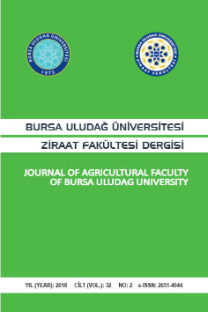Prediction of albumen weight, yolk weight, and shell weight as egg weight in japanese quail eggs
yumurta ağırlığı, yumurta kalitesi, yumurta sarısı, fenotipik korelasyon, kümes hayvanları, Japon bıldırcını, öngörü, matematiksel modeller, yumurta albumini, yumurta kabuğu
Japon bıldırcını yumurtalarında yumurta ağırlığı kullanılarak ak ağırlığı, sarı ağırlığı ve kabuk ağırlığının tahmin edilmesi
egg weight, egg quality, egg yolk, phenotypic correlation, poultry, Japanese quails, prediction, mathematical models, egg albumen, egg shell,
___
1. ALTAN O, OGUZ I, AKBAS Y. Effects of selection for high body weight and age of hen on egg characteristics in Japanese quail (Coturnix coturnix japonica). Turk J. Vet. Anim. Sci. 1998; 22: 67- 473.2. ALTINEL A., GUNES H, KIRMIZIBAYRAK T, COREKCI SG, BILAL T. The studies on egg quality characteristics of Japanese quails. J. Fac. Vet. Univ. Istanbul. 1996; 22: 203-213.
3. ANONYMUS. SPSS for windows, Release 9.0. Standard version. Copyright SPSS Inc. 1999.
4. AR, A, RAHN H, PAGANELLI CV. The avian egg: mass and strength. Condor. 1979; 8I: 331-337.
5. MORRIS H., HESSELS DF, BISHOP RJ. The relationship between hatching egg weight and subsequent performance of broiler chickens. Brit. Poult. Sci. 1968; 5: 305-315.
6. NARAHARI D, ABDUL-MUJEV K, THANGAVEL A, RAMAMURTY N, VISUNATHAN S, MOHAN B, MURGANANDA B, SUNRARAROSU V. Traits influencing the hatching performance of Japanese quail eggs. Brit. Poult. Sci. 1988; 29: 101-112.
7. NARUSHIN VG. Express method for determination of egg morphological parameters. 9th European Poultry Conference. Proceeding, Glasgow (DK). 1994, 1: 385-386.
8. NARUSHIN VG, YAKUPOGLU C, J DVORSKA. Morphological composition of quail eggs. IX European symposium on the quality of eggs and egg products. Kusadasi, Turkey, 2001, 387-392.
9. PANDEV NK, MAHAPATRA CM, VERMA SS, GOYAL RC. JAHARI DC. Physical quality traits and components of egg from different strains of white leghorn hens. Indian J. Poult. Sci. 1984; 1: 40-44.
10. PEEBLES ED, MARKS HL. Effects of selection for growth and selection diet on egg shell quality and embryonic development in Japanese quail. Poultry Sci. 1991; 70: 1471 - 1480.
11. POGGEPEL DG. Correlated response in shell and albumen quality with selection for increased egg production. Poult. Sci. 1986; 65: 1633-1641.
12. ROLAND DA. Crack down on cracked eggs. Poultry International. July, 1981, 38-53.
13. SINGH RP, PANDA B. Effect of seasons on physical quality and component yields of egg from different lines of quail. Indian Journal of Animal Sci. 1987; 57: 50-55.
14. SNEDECOR GW, COCHRAN WG. Statistical method. Seventh edition. The Iowa State University Press, Ames, Iowa, D-S.A. 1980.
15. WILSON HR. Interrelationships of egg size, chick size post-hatching growth and hatchability. World's Poult. Sci. 1991; 47: 5-20.
16. YANNAKOPOULOS AL, TSERVENI-GOUSI AS. Quality characteristics of quail eggs. Brit. Poult. Sci. 1986; 27: 171-176.
- ISSN: 1301-3173
- Yayın Aralığı: Yılda 2 Sayı
- Başlangıç: 1981
- Yayıncı: Ahmet Akkoç
Köpeklerde farklı siklus evrelerindeki vaginal bakteriyel floranın incelenmesi
ÜLGEN GÜNAY, AYTEKİN GÜNAY, Mihriban ÜLGEN, A. Ebru ÖZEL
Küçük hayvanlarda sintigrafi uygulamaları
Bilinmeyen bir ürün: Beç tavuğu
Bayazıt MUSAL, Kamil SEYREK, Pınar A. ULUTAŞ
Tam yağlı soyanın metabolik enerji değerinin broyler performansından tahmini
Nizamettin Şenköylü, Hasan AKYÜREK, H. Ersin ŞAMLI, AYLİN AĞMA OKUR
Tavuk ve horozların gelişme sürecinde hipofiz bezi pars distalisinin histolojik yönden incelenmesi
YAVUZ NAK, Deniz MISIRLIOĞLU, DENİZ NAK, Bilginer TUNA, İsmail Hakkı KUMRU, AYLİN ALASONYALILAR DEMİRER
Tarımsal ve hayvansal ürünlerde modern biyoteknoloji ve organik üretim
CENK AYDIN, Engin KENNERMAN, NURTEN GALİP, Murat YALÇIN, Füsun AK, Cüneyt KAYAALP
